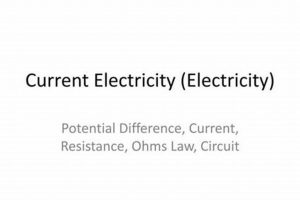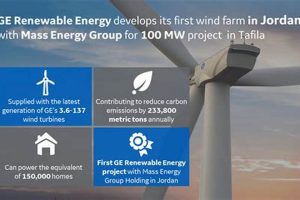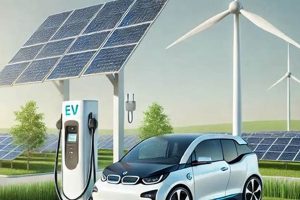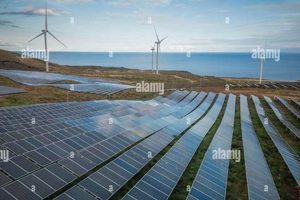Harnessing the vast power of the ocean for clean electricity generation involves several key technologies. These methods exploit various natural phenomena, including the motion of waves, tides, and currents, as well as differences in temperature and salinity. For example, wave energy converters capture the kinetic energy of waves and transform it into electricity, while tidal barrages utilize the predictable rise and fall of tides to generate power. Ocean thermal energy conversion, on the other hand, exploits the temperature difference between warm surface water and cold deep water to create a thermal cycle that drives a turbine.
Developing these marine energy resources offers significant advantages. It contributes to diversifying energy portfolios, reducing reliance on fossil fuels, and mitigating climate change. Furthermore, these resources are predictable and consistently available, unlike intermittent renewable sources like solar and wind. Historically, the utilization of ocean energy has been limited. However, advances in technology and growing concerns about environmental sustainability are driving renewed interest and investment in this field, making it a promising area for future energy production.
This article will explore the various technologies employed to extract renewable energy from the ocean, analyzing their potential, current limitations, and future prospects. Specific methods, such as wave energy conversion, tidal power generation, and ocean thermal energy conversion, will be examined in detail. Additionally, the environmental and economic impacts of these technologies will be considered, offering a comprehensive overview of this vital area of renewable energy development.
Tips for Advancing Ocean Energy Technologies
Further development and wider implementation of ocean energy technologies require careful consideration of various factors. The following tips offer guidance for stakeholders involved in this crucial field:
Tip 1: Invest in Research and Development: Continued research is essential for improving the efficiency, durability, and cost-effectiveness of ocean energy technologies. This includes exploring novel materials, optimizing designs, and refining energy conversion processes.
Tip 2: Address Environmental Impacts: Thorough environmental impact assessments are crucial for minimizing potential negative effects on marine ecosystems. Careful site selection, mitigation strategies, and ongoing monitoring are necessary.
Tip 3: Foster Public-Private Partnerships: Collaboration between governments, research institutions, and private companies is essential for accelerating the development and deployment of these technologies. This includes funding initiatives, regulatory frameworks, and knowledge sharing.
Tip 4: Streamline Permitting Processes: Clear and efficient permitting procedures can facilitate project development and reduce administrative burdens. This requires coordination among various regulatory agencies and stakeholders.
Tip 5: Develop Grid Integration Strategies: Integrating ocean energy into existing power grids requires careful planning and infrastructure development. This includes assessing grid capacity, transmission lines, and energy storage solutions.
Tip 6: Promote Public Awareness: Educating the public about the benefits and challenges of ocean energy can foster acceptance and support for these technologies. This includes outreach programs, educational materials, and community engagement.
Tip 7: International Collaboration: Sharing best practices, research findings, and technological advancements across borders can accelerate the global adoption of ocean energy. This fosters innovation and efficient resource allocation.
By addressing these key aspects, the potential of ocean energy can be fully realized, contributing significantly to a sustainable energy future. These efforts are essential for mitigating climate change and ensuring a secure energy supply for future generations.
These tips provide a roadmap for future development in the field, highlighting the importance of a multi-faceted approach. The following conclusion will summarize the key takeaways and offer a perspective on the future of ocean energy.
1. Wave Energy Conversion
Wave energy conversion represents a significant pathway toward harnessing the renewable energy potential of ocean water. This process transforms the kinetic energy inherent in ocean waves into usable electricity. The continuous motion of waves, driven by wind and other natural forces, provides a consistent and predictable energy source. Wave energy converters (WECs) operate through various mechanisms, including oscillating water columns, point absorbers, and overtopping devices. These mechanisms capture the wave’s motion and convert it into mechanical energy, which subsequently drives a generator to produce electricity. The Pelamis, a semi-submerged, articulated structure composed of interconnected cylindrical sections, exemplifies a type of WEC that generates power as waves cause its sections to flex and activate hydraulic rams connected to generators. Another example is the Wave Star, which employs floats attached to arms fixed to a platform; the rising and falling of these floats due to wave action drives hydraulic systems to generate electricity. These examples illustrate the diverse approaches to capturing and converting wave energy.
The importance of wave energy conversion within the broader context of ocean energy extraction stems from its potential to contribute significantly to a sustainable energy mix. Wave energy is a clean and renewable resource, reducing dependence on fossil fuels and mitigating greenhouse gas emissions. Coastal regions, particularly those with consistent wave activity, stand to benefit significantly from this localized energy source. Practical applications of wave energy conversion extend beyond electricity generation for individual communities. Large-scale wave farms could power offshore industries, desalination plants, or even contribute to national grids. The predictability of wave patterns enables more reliable energy forecasting compared to other intermittent renewable sources like solar or wind, enhancing grid stability.
Wave energy conversion offers a viable and sustainable pathway for turning ocean water into renewable energy. While challenges remain, including technological advancements, cost optimization, and environmental impact mitigation, ongoing research and development continue to improve the efficiency and viability of WECs. Addressing these challenges is crucial for unlocking the full potential of wave energy as a key component of a sustainable energy future. The ongoing exploration and refinement of wave energy conversion technologies are essential steps toward realizing the vast untapped potential of the worlds oceans as a clean and sustainable energy source.
2. Tidal power generation
Tidal power generation stands as a prominent method for converting the cyclical movement of ocean tides into a usable energy source. This process leverages the gravitational forces exerted by the moon and sun on Earths oceans, creating predictable and consistent tidal currents. Harnessing this natural phenomenon involves strategically positioning turbines in areas with high tidal flow. As water moves through these turbines, they rotate, driving generators to produce electricity. Several established approaches exist, including tidal barrages, tidal fences, and tidal turbines. Tidal barrages are dam-like structures that capture water during high tide and release it during low tide, driving turbines in the process. Tidal fences consist of a row of turbines installed perpendicular to the tidal flow, capturing energy as water passes through them. Tidal turbines, similar to underwater wind turbines, are placed directly in the path of tidal currents. The Rance Tidal Power Station in France, utilizing a tidal barrage, and the MeyGen tidal stream project in Scotland, employing underwater turbines, exemplify practical implementations of tidal power generation.
The significance of tidal power within the broader scope of ocean energy extraction lies in its predictable and consistent nature. Unlike other renewable sources, such as solar and wind, tidal patterns are highly predictable, allowing for reliable energy generation forecasting and integration into power grids. This predictability reduces reliance on energy storage solutions, a critical factor in grid stability. Coastal communities, particularly those experiencing substantial tidal ranges, benefit directly from locally generated tidal power, enhancing energy independence and reducing transmission losses. Furthermore, tidal power generation contributes to reducing greenhouse gas emissions and reliance on fossil fuels, aligning with global sustainability goals. The consistent output and minimal environmental impact of tidal energy, compared to traditional fossil fuel-based power plants, position it as a key component of a diverse and sustainable energy portfolio.
Tidal power generation offers a reliable and sustainable pathway for converting ocean water’s natural energy into a practical resource. While challenges persist, including initial capital costs, potential impacts on marine ecosystems, and site-specific suitability limitations, ongoing advancements in turbine technology and environmental impact mitigation strategies continue to improve the viability and efficiency of tidal power projects. Continued investment in research, development, and responsible implementation will be essential for maximizing the contribution of tidal energy to a sustainable energy future. The consistent and predictable nature of tidal energy makes it a compelling component of a diversified renewable energy strategy, lessening dependence on less predictable sources and contributing significantly to the overall goal of clean and sustainable energy production.
3. Ocean Thermal Energy Conversion
Ocean thermal energy conversion (OTEC) presents a unique approach to harnessing the ocean’s potential as a renewable energy source. Unlike methods that capture the kinetic energy of waves or tides, OTEC exploits the temperature difference between warm surface waters and cold deep waters to generate electricity. This temperature gradient, a consequence of solar radiation absorption at the surface, creates a thermal engine capable of driving a turbine and producing clean energy.
- Closed-Cycle OTEC Systems
Closed-cycle systems utilize a working fluid with a low boiling point, such as ammonia. Warm surface water heats and vaporizes this fluid, which then drives a turbine connected to a generator. Cold deep-ocean water subsequently condenses the vapor back into a liquid state, completing the cycle. This closed loop ensures minimal environmental impact and efficient energy conversion. A land-based closed-cycle OTEC plant in Hawaii serves as a practical example of this technology. This approach allows for consistent energy production due to the stable temperature difference between surface and deep waters.
- Open-Cycle OTEC Systems
Open-cycle systems directly utilize warm surface water. The warm water is flash-evaporated in a low-pressure chamber, creating steam that drives a turbine. The resulting low-pressure steam can also be used for freshwater production through condensation. A pilot open-cycle OTEC plant in the Pacific Islands demonstrates this technology’s potential for combined power and freshwater generation, crucial for remote island communities. While technically simpler than closed-cycle systems, challenges related to maintaining low pressure and scaling for large-scale power generation remain.
- Hybrid OTEC Systems
Hybrid systems combine elements of both closed and open cycles, aiming to maximize benefits and mitigate limitations. These systems often incorporate aspects of open-cycle systems for freshwater production alongside closed-cycle systems for efficient electricity generation. Research and development efforts focus on optimizing hybrid systems to balance the advantages of both approaches, offering the potential for integrated power and freshwater solutions in coastal regions. While still in the developmental stage, hybrid systems hold significant promise for maximizing the resource potential of OTEC technology.
- Potential and Challenges of OTEC
OTEC possesses considerable potential as a sustainable energy source, particularly for tropical and subtropical regions with significant temperature differences between surface and deep waters. However, high initial capital costs, technical complexities associated with deep-water pipe deployment, and potential environmental impacts related to nutrient upwelling and marine life interaction pose significant challenges. Ongoing research and development aim to address these challenges, enhance efficiency, and reduce costs, paving the way for wider adoption of OTEC technology. Successfully addressing these challenges will unlock the significant contribution OTEC can make to sustainable energy production.
The diverse approaches within OTEC highlight the ingenuity of leveraging natural temperature gradients for sustainable energy generation. While challenges persist, ongoing advancements and pilot projects demonstrate the potential of OTEC to contribute significantly to a cleaner energy future, particularly in regions with favorable oceanic conditions. OTEC stands as a testament to the diverse possibilities inherent in harnessing the ocean’s resources for renewable energy production, playing a vital role in the transition towards a more sustainable energy landscape.
4. Current Energy Converters
Current energy converters represent a key technology in harnessing the kinetic energy of ocean currents for renewable electricity generation. These devices operate on principles similar to wind turbines, capturing the energy of moving water to drive turbines and generate power. Ocean currents, driven by wind, temperature, and salinity gradients, offer a predictable and consistent energy source, unlike intermittent renewable sources such as solar and wind. The placement of these converters in areas with strong and consistent currents is crucial for maximizing energy capture. Several types of current energy converters exist, including horizontal axis turbines, vertical axis turbines, and oscillating hydrofoils. Horizontal axis turbines, resembling underwater wind turbines, are the most common type, while vertical axis turbines and oscillating hydrofoils offer alternative approaches with potential advantages in certain environments. The SeaGen project in Northern Ireland, utilizing horizontal axis turbines, serves as a notable example of a grid-connected current energy converter system.
The importance of current energy converters within the broader context of ocean energy extraction lies in their ability to tap into a vast and consistently available energy resource. Ocean currents represent a predictable and continuous source of kinetic energy, reducing reliance on energy storage solutions and contributing to grid stability. Furthermore, current energy conversion minimizes greenhouse gas emissions and dependence on fossil fuels, supporting global sustainability goals. Areas with strong ocean currents, often located near coastlines, can benefit significantly from this localized energy source, potentially reducing transmission losses and enhancing energy independence. Practical applications of current energy converters extend beyond grid-connected electricity generation. These devices can power offshore platforms, desalination plants, or even provide remote power for isolated communities. The consistent energy supply from ocean currents makes them a valuable resource for a variety of applications.
Current energy converters offer a promising pathway for converting the kinetic energy of ocean currents into a valuable and sustainable energy resource. While challenges remain, including technological advancements for harsh marine environments, cost optimization, and potential impacts on marine ecosystems, ongoing research and development are continuously improving the efficiency, durability, and environmental compatibility of these devices. Addressing these challenges is crucial for unlocking the full potential of current energy converters and integrating them into a diversified renewable energy portfolio. Continued exploration and refinement of current energy conversion technologies represent a significant step towards realizing the vast potential of ocean currents as a clean and sustainable energy source.
5. Osmotic Power Systems
Osmotic power systems, also known as pressure-retarded osmosis (PRO), represent a novel approach to harnessing renewable energy from the ocean. This technology exploits the natural energy released when freshwater and saltwater mix. Specifically, PRO utilizes a semi-permeable membrane to separate two solutions with different salinity levels. Water molecules naturally move across this membrane from the less concentrated solution (freshwater) to the more concentrated solution (saltwater), driven by osmotic pressure. This movement of water increases the pressure on the saltwater side, which can then be harnessed to drive a turbine and generate electricity. The Statkraft osmotic power prototype plant in Tofte, Norway, exemplified this process, although it was later decommissioned due to scaling and membrane fouling challenges.
The significance of osmotic power lies in its potential to generate renewable energy from a readily available resource: the salinity gradient between freshwater and seawater. Estuaries, where rivers meet the ocean, represent ideal locations for implementing PRO systems due to the natural mixing of fresh and saltwater. This technology offers a sustainable alternative to traditional energy sources, reducing reliance on fossil fuels and mitigating greenhouse gas emissions. Furthermore, osmotic power can be implemented in various locations globally, provided a suitable salinity gradient exists, offering potential benefits for coastal communities and regions with access to both freshwater and saltwater resources. Researchers are actively exploring innovative membrane materials and system designs to enhance the efficiency and durability of PRO systems, addressing challenges such as membrane fouling and cost-effectiveness. For example, research focuses on developing biomimetic membranes inspired by biological systems, which exhibit superior performance and resistance to fouling.
Osmotic power systems offer a unique approach to renewable energy generation, leveraging the natural salinity gradient between freshwater and seawater. While practical implementation faces challenges related to membrane technology and cost-effectiveness, ongoing research and development efforts continue to advance this promising field. Successfully addressing these challenges could unlock the significant potential of osmotic power as a sustainable and globally applicable energy source, contributing to a diversified renewable energy portfolio. Further exploration and refinement of osmotic power technologies remain crucial for realizing the full potential of this innovative approach to clean energy generation, diversifying the renewable energy landscape and contributing to a more sustainable future.
6. Salinity Gradient Power
Salinity gradient power, the energy derived from the difference in salt concentration between freshwater and seawater, represents a promising avenue for renewable energy generation within the broader context of harnessing ocean power. This approach taps into a vast and continuously replenished energy source, offering a sustainable alternative to traditional energy sources. Exploring the various methods of extracting this energy provides crucial insights into the potential of salinity gradients to contribute significantly to a cleaner energy future.
- Pressure-Retarded Osmosis (PRO)
PRO utilizes a semi-permeable membrane to separate freshwater and seawater. The natural osmotic pressure drives freshwater across the membrane, increasing the pressure on the seawater side, which then drives a turbine. While theoretically promising, practical challenges related to membrane fouling and cost-effectiveness hinder widespread implementation. The Statkraft osmotic power prototype in Norway served as a valuable learning experience, highlighting the need for further research and development in membrane technology and system design.
- Reverse Electrodialysis (RED)
RED exploits the difference in ionic concentration between freshwater and seawater to generate electricity. Selective membranes allow the passage of specific ions, creating an electrical potential difference that can be harnessed. Ongoing research focuses on improving membrane selectivity and durability, addressing challenges related to fouling and cost. Pilot RED installations, like the one at the Afsluitdijk dike in the Netherlands, demonstrate the potential of this technology for practical applications.
- Capacitive Mixing (CapMix)
CapMix utilizes the electrical double-layer formed at the interface between electrodes and saltwater. Mixing freshwater and seawater in a capacitive system alters the ionic concentration and generates an electrical current. While still in its early stages of development, CapMix offers potential advantages in terms of scalability and reduced membrane fouling compared to PRO and RED. Laboratory-scale experiments demonstrate the feasibility of this approach, but further research is needed to assess its long-term viability and potential for large-scale implementation.
- Vapor Pressure Difference Utilization
Another emerging approach involves harnessing the difference in vapor pressure between freshwater and seawater. Warm seawater can evaporate freshwater in a closed system, creating pressure that drives a turbine. This method bypasses the challenges associated with membranes in PRO and RED, offering a potentially simpler and more robust solution. Research and development efforts are focusing on optimizing the efficiency of this process and exploring suitable materials for implementation. This relatively new approach requires further investigation to assess its practical viability and potential contribution to salinity gradient power generation.
Salinity gradient power offers diverse pathways for converting the chemical potential energy stored in the difference between freshwater and seawater into a valuable renewable resource. While each method faces unique challenges, ongoing research and development continue to push the boundaries of these technologies. Successfully addressing these challenges, particularly related to membrane technology, cost-effectiveness, and system durability, will be crucial for unlocking the full potential of salinity gradient power and its significant contribution to a sustainable energy future. Further exploration and refinement of these technologies are essential steps toward realizing the promise of salinity gradient power as a viable and impactful renewable energy source, playing a crucial role in the global transition towards a cleaner and more sustainable energy landscape.
Frequently Asked Questions
This section addresses common inquiries regarding the conversion of ocean water into renewable energy, providing concise and informative responses.
Question 1: What are the primary methods for harnessing ocean energy?
Several technologies exist for converting ocean energy into electricity, including wave energy converters, tidal barrages and turbines, ocean thermal energy conversion, current energy converters, and salinity gradient power systems. Each method leverages different oceanic properties, such as wave motion, tidal currents, temperature differences, and salinity gradients.
Question 2: How does wave energy conversion work?
Wave energy converters capture the kinetic energy of ocean waves and transform it into electricity. Various designs exist, including oscillating water columns, point absorbers, and overtopping devices, each utilizing unique mechanisms to capture wave motion and drive a generator.
Question 3: What is the difference between tidal barrages and tidal turbines?
Tidal barrages are dam-like structures built across estuaries or bays, capturing water during high tide and releasing it through turbines during low tide to generate electricity. Tidal turbines, similar to underwater wind turbines, are placed directly in the path of tidal currents, capturing the kinetic energy of moving water.
Question 4: How does ocean thermal energy conversion (OTEC) generate power?
OTEC exploits the temperature difference between warm surface waters and cold deep waters. This temperature gradient drives a thermal cycle that utilizes a working fluid to generate electricity. Both closed-cycle and open-cycle OTEC systems exist, each with specific advantages and challenges.
Question 5: What are the environmental impacts of harnessing ocean energy?
While generally considered environmentally friendly, ocean energy technologies can have localized impacts on marine ecosystems. These may include alterations to seabed habitats, noise pollution affecting marine mammals, and potential entanglement of marine life in mooring lines or other equipment. Careful site selection, environmental impact assessments, and mitigation strategies are crucial for minimizing potential negative effects.
Question 6: What are the future prospects for ocean energy?
Ocean energy holds significant promise for contributing to a sustainable energy future. Continued research and development, coupled with supportive policies and investment, are essential for overcoming technological challenges, reducing costs, and promoting wider deployment of these technologies. The future of ocean energy hinges on successfully addressing these aspects to unlock its full potential.
Understanding these key aspects of ocean energy conversion is crucial for informed decision-making and promoting the responsible development of this promising renewable energy resource. Addressing these common inquiries provides a foundational understanding of the key principles and considerations associated with harnessing the power of the ocean for sustainable energy production.
The following conclusion summarizes the key benefits and challenges associated with harnessing ocean energy, providing a perspective on the future of this important field.
Conclusion
Exploration of ocean energy conversion technologies reveals significant potential for contributing to a sustainable energy future. Methods such as wave energy conversion, tidal power generation, ocean thermal energy conversion, current energy converters, and salinity gradient power offer diverse pathways for harnessing the vast and constantly replenished energy resource of the ocean. These technologies offer distinct advantages, including predictability, reduced greenhouse gas emissions, and potential for localized energy production, reducing reliance on fossil fuels and enhancing energy independence. However, challenges remain, including technological advancements for harsh marine environments, cost competitiveness, grid integration complexities, and potential environmental impacts. Addressing these challenges through continued research, development, and strategic implementation is crucial for realizing the full potential of ocean energy.
The future of energy sustainability hinges on diversifying energy portfolios and embracing innovative solutions. Ocean energy conversion technologies represent a critical component of this transition, offering a pathway towards a cleaner, more secure, and sustainable energy future. Continued investment in research, development, and responsible implementation of these technologies is essential not only for meeting growing energy demands but also for mitigating the impacts of climate change and ensuring a healthy planet for future generations. The ocean’s vast energy potential remains largely untapped, representing a significant opportunity for innovation, economic growth, and environmental stewardship. Realizing this potential requires a concerted global effort, fostering collaboration, innovation, and a commitment to sustainable practices to unlock the immense power of the ocean for the benefit of all.







